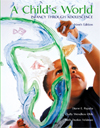 |  A Child's World: Infancy through Adolescence, 9/e Diane E. Papalia,
University of Wisconsin-Madison
Sally Wendkos Olds
Ruth Duskin Feldman
Cognitive Development in Early Childhood
Learning Objectives
LEARNING OBJECTIVES FOR SECTION IAfter reading and reviewing this section of Chapter 10, you should be able to
do the following.
Tell what Piaget observed to be the chief difference between children's
cognitive abilities in early childhood and middle childhood.
Name five cognitive advances of the preoperational stage and explain
their significance.
Name three ways in which young children display the symbolic function,
and give an example of each.
Give an example of each of the following achievements: understanding
of identities, understanding of cause and effect, and ability to classify.
List five principles of counting that children recognize by early childhood.
Give examples of each of the following limitations Piaget observed in
preoperational thought: centration, irreversibility, focus on states rather
than on transformations, transductive reasoning, and egocentrism.
Identify and describe seven types of conservation and give an example
of each.
Explain why Piaget may have underestimated children's thought processes,
and discuss research on egocentrism, animism, and empathy which challenges
his conclusions.
Discuss four aspects of young children's theory of mind, according to
current research.
Tell under what circumstances cognitive abilities can be accelerated
through training.
|
 |  |  | LEARNING OBJECTIVES FOR SECTION IIAfter reading and reviewing this section of Chapter 10, you should be able to
do the following.
Identify advances in vocabulary, grammar, and syntax during early childhood,
and name four limitations on young children's use of language.
Identify advances in young children's ability to communicate through
speech.
List seven types of private speech, and give an example of each type.
Compare two views of the function and value of private speech, tell
which view seems to be supported by research, and point out practical implications.
Discuss causes, implications, and treatment of delayed language development.
Identify three factors that can foster the development of literacy.
Discuss how parents foster young children's narrative skills.
|
 |  |  | LEARNING OBJECTIVES FOR SECTION IIIAfter reading and reviewing this section of Chapter 10, you should be able to
do the following.
Distinguish between recognition and recall, tell which is more difficult
for young children, and name two factors influencing how well young children
recall.
Explain the difference between implicit and explicit memory, and tell
how it helps explain infantile amnesia.
Distinguish among generic memory, episodic memory, and autobiographical
memory, and discuss the possibility of a link between autobiographical memory
and language.
Identify and discuss factors that influence young children's ability
to remember an event.
|
 |  |  | LEARNING OBJECTIVES FOR SECTION IVAfter reading and reviewing this section of Chapter 10, you should be able to
do the following.
Explain why psychometric tests are more reliable for preschoolers than
for infants.
Name and describe two psychometric intelligence tests used with young
children.
List several factors that influence children's performance on intelligence
tests.
Assess the impact of musical training on spatial reasoning.
Explain the relationships between socioeconomic status and other factors
than can influence IQ.
Explain how Vygotsky's concepts of the zone of proximal development
and scaffolding can be used to assess and develop young children's cognitive
potential.
|
 |  |  | LEARNING OBJECTIVES FOR SECTION VAfter reading and reviewing this section of Chapter 10, you should be able to
do the following.
Give examples of cultural differences in goals for, and methods of, preschool
education in the United States, Japan, and China.
Tell at least two ways in which a good preschool can foster children's
development.
State the goals of compensatory preschool programs, and assess the short-term
and long-term benefits of Project Head Start and other compensatory programs.
Summarize research on the value and long-term effects of an academic
emphasis in preschool and kindergarten.
Give pros and cons of full-day kindergarten.
Name at least two predictors of future school achievement that can be
observed in kindergarten.
Assess the long-term effects of delayed school entrance.
|
|



 2002 McGraw-Hill Higher Education
2002 McGraw-Hill Higher Education